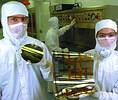Prototypes of paper-like flexible displays expected next year
24 October 2001
Opto-Electronics

E Ink, a developer of 'electronic ink technology' for paper-like displays, has opened a new flexible microelectronics facility in Woburn, Mass. E Ink's Microelectronics Technology Group will develop microelectronics, including flexible transistors, which will enable E Ink to create paper-like display prototypes next year. The new semiconductor facility is the first in the world devoted exclusively to developing flexible transistors for use in electronic displays.
"Despite the current economic climate, E Ink is investing heavily in R&D and is poised for dramatic growth next year," said Jim Iuliano, President and CEO of E Ink. "Our new semiconductor facility will be one of the foremost in the world for the development of flexible displays and moves us closer to 'RadioPaper', E Ink's ultimate vision for a wireless display that looks and feels like paper."
The flexible electronic ink displays are based on new transistor designs and novel materials and processes. Such active matrix displays could be rolled and flexed as easily as paper, say the manufacturers. Using proprietary equipment the group will work with traditional silicon-based, thin-film transistors as well as a variety of printed conductor and semiconductor materials, including organic, plastic transistors.
This year, E Ink won an R&D 100 award from R&D Magazine for its demonstration in November 2000 of the world's first working flexible active matrix display using plastic transistors from Lucent Technologies. In June 2001, E Ink demonstrated the first high-resolution (40 dpi) flexible active matrix display using a novel silicon transistor design that was manufactured on a flexible steel foil.
www.eink.com
Further reading:
Versatile range of camera modules
EBV Electrolink
Opto-Electronics
The CAM-66GY pro-modules from ST are a full range of sample camera modules made for a seamless evaluation and integration of the VD66GY 1,5-megapixel colour image sensor.
Read more...
Enhanced breaker status and communication module
Schneider Electric South Africa
Opto-Electronics
Schneider Electric has announced the launch of its new Breaker Status and Communication Module (BSCM) Modbus SL/ULP, which delivers enhanced performance, improved connectivity, and simplified integration for power distribution systems.
Read more...
Heat-resistant LEDs
Opto-Electronics
Würth Elektronik’s new RGB LEDs are characterised by excellent heat resistance with an insensitivity to temperatures from -40 to 100°C making them ideal solutions for reliable, colour-variable lighting in applications at high operating temperatures.
Read more...
PhotoMOS relays
Future Electronics
Opto-Electronics
The AQY221R2SX and AQY221R2S PhotoMOS from Panasonic Industry ensures excellent characteristics and high-speed switching performance.
Read more...
Mouser now shipping onsemi’s image sensors
TRX Electronics
Opto-Electronics
The AR0145CS is a 1/4,3-inch CMOS digital image sensor with a 1280 (H) x 800 (V) active-pixel array that can capture both continuous video and single frames.
Read more...
Adaptive optics’ power solution
Altron Arrow
Opto-Electronics
Vicor power-dense adaptive optical modules enable colossal telescopes to look into the past for deep space discoveries.
Read more...
Ultra-high speed photo detection
Opto-Electronics
TDK Corporation has announced a photo-spintronic conversion element combining optical, electronic, and magnetic elements that can respond at an ultra-high speed of 20 picoseconds.
Read more...
High-speed lasers
RFiber Solutions
Opto-Electronics
Macom are a high-volume manufacturer of lasers, deploying more than 100 million devices with a reliability of less than 50 FIT and greater than 100 years of wear-out lifetime
Read more...
High-performance optical interconnect
Opto-Electronics
STMicroelectronics has unveiled its next generation of proprietary technologies for higher-performing optical interconnect in datacentres and AI clusters.
Read more...
Halo mid-board optical transceiver
Spectrum Concepts
Opto-Electronics
The Samtec Halo mid-board transceiver has been designed for next-generation embedded applications that require 56 and 112 Gbps PAM4 performance in low profile and ruggedised form factors.
Read more...


